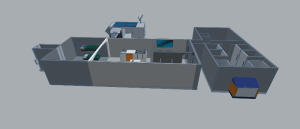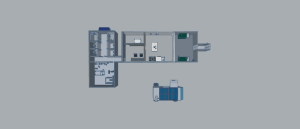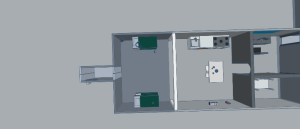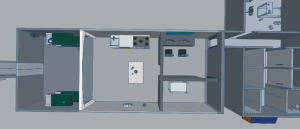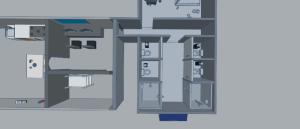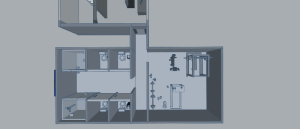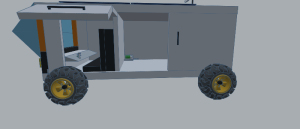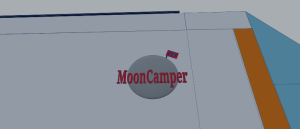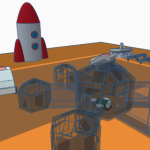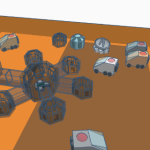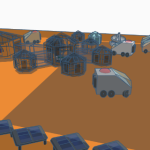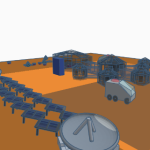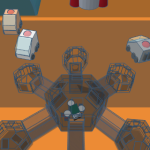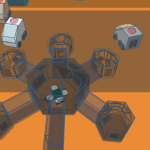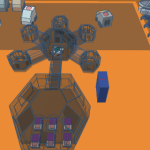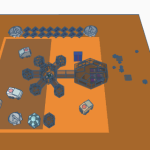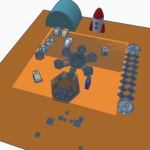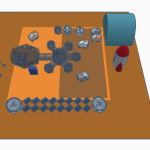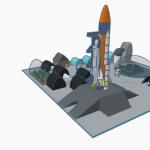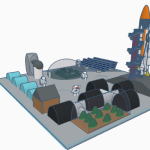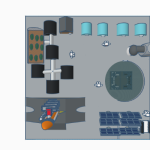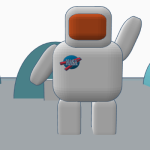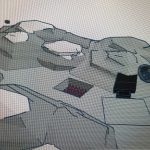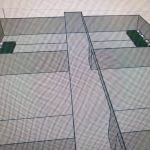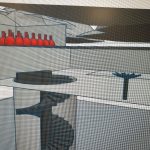MOON CAMP – Modello 3D in Tinkercad by Martino C., Umberto D., Enrico M., Davide M., Matteo M., Giovanmattia M., Anna V.
Scuola Santa Giovanna d’Arco Vittorio Veneto-TV Italy 13 years old 7 / 1 Italian Moon
External link for Tinkercad 3D design
Project description
Sbalzi termici
La temperatura sulla luna oscilla tra giorno e notte dai -133°C (a volte anche -247°C) ai +121°C.
Soluzione: La costruzione della base dovrà avvenire in luoghi prestabiliti, come il polo sud della luna dove la temperatura è più stabile (intorno ai 260K / -13°C) e come misura di sicurezza le uscite saranno permesse solo in orari prestabiliti.
Niente atmosfera
Questo comporta due problemi: Asteroidi e raggi cosmici; Se non c’è atmosfera, gli asteroidi possono causare danni alla base e agli astronauti. D’altra parte, l’esposizione prolungata degli astronauti ai raggi cosmici, può causare problemi al sistema immunitario e al DNA, come i tumori.
Soluzione: Una sonda più pesante di un oggetto celeste può cambiare la direzione di quest’ultimo usando la sua gravità, agendo come un “trattore gravitazionale”.
Per affrontare il problema delle radiazioni cosmiche, si possono utilizzare materiali speciali, come una particolare tecnologia chiamata EST (Elettrostatic Shield Technology) che aiuta a proteggere le attrezzature elettroniche nello spazio, garantendone il corretto funzionamento.
Per proteggere gli astronauti, si possono impiegare materiali come alluminio, acqua e altri contenenti idrogeno. Questi sembrano essere resistenti alle radiazioni cosmiche, offrendo una forma di protezione.
Acqua, ossigeno e cibo
Dove li ricaviamo?
Soluzione: Per quanto riguarda il cibo, nella base lunare è previsto un laboratorio per la coltivazione di carne in vitro e un orto autosufficiente che fornirà una fonte di prodotti vegetali. In questo modo, la base sarà in grado di produrre il necessario sostentamento.
Per l’approvvigionamento idrico, nella zona polare della Luna è presente del ghiaccio. Questo ghiaccio può essere estratto e trasformato in acqua per le necessità della base. Gli astronauti potranno utilizzare un processo di riciclo avanzato, che prevede il trattamento delle urine attraverso tecniche di purificazione. Questo permetterà di ottenere acqua pulita e riutilizzabile per le varie attività all’interno della base lunare.
L’atmosfera terrestre è costituita principalmente da azoto (78), ossigeno (21%), argon (0.9%) e altri gas in proporzioni minori.
Sicuramente necessario è l’ossigeno, ma l’azoto è altrettanto essenziale. Nonostante sembri ininfluente, è fondamentale per l’uomo. Mentre l’ossigeno può essere ottenuto dalla regolite lunare, sembra che l’azoto non sia naturalmente presente sulla Luna. Ciò significa che dovremo trovare soluzioni alternative o trasportare azoto dalla Terra per garantire un ambiente vitale nella base lunare.
Bassa gravità
Essendo sulla luna la gravità 1/6 di quella terrestre gli astronauti possono sviluppare malattie allo scheletro, come osteoporosi e deterioramento osseo
Soluzione: L’installazione di palestre preverrà questi tipi di problemi.
Giorno e notte
Sulla luna il ciclo giorno-notte avviene ogni 28 giorni e questo può portare disorientamento degli astronauti e ricercatori e in casi gravi anche depressione, ma per questo problema si potranno installare schermi che fungeranno da finestre, mostrando immagini notturne e giornaliere in corrispondenza delle esigenze, così che gli astronauti possano sentirsi a proprio agio nella base.
Il progetto è accompagnato dal brano musicale “ASTROMUSIC” realizzato per Moon Camp Challenge.
Project link
https://mooncampchallenge.org/wp-content/uploads/2024/04/AstroMusic.mp3
English translation
Thermal changes
The temperature on the moon fluctuates between day and night from -133°C (sometimes even -247°C) to +121°C.
Solution: The construction of the base will have to take place in pre-established places, such as the south pole of the moon where the temperature is more stable (around 260K / -13°C) and as a safety measure exits will only be allowed at pre-established times.
No atmosphere
This leads to two problems: Asteroids and cosmic rays; If there is no atmosphere, asteroids can cause damage to the base and astronauts. On the other hand, prolonged exposure of astronauts to cosmic rays can cause problems with the immune system and DNA, such as tumors.
Solution: A probe heavier than a celestial object can change the object’s direction using its gravity, acting as a “gravity tractor.”
To address the problem of cosmic radiation, special materials can be used, such as a particular technology called EST (Electrostatic Shield Technology) which helps protect electronic equipment in space, ensuring its correct functioning.
To protect astronauts, materials such as aluminum, water and others containing hydrogen can be used. These appear to be resistant to cosmic radiation, offering a form of protection.
Water, oxygen and food
Where do we get them?
Solution: As for food, the moon base plans to have an in vitro meat cultivation lab and a self-sustaining vegetable garden that will provide a source of plant-based produce. In this way, the base will be able to produce the necessary sustenance.
For water supply, ice is present in the polar area of the Moon. This ice can be mined and turned into water for the base’s needs. Astronauts will be able to use an advanced recycling process, which involves treating urine through purification techniques. This will allow us to obtain clean and reusable water for the various activities within the lunar base.
The Earth’s atmosphere is mainly made up of nitrogen (78), oxygen (21%), argon (0.9%) and other gases in smaller proportions.
Oxygen is certainly necessary, but nitrogen is equally essential. Although it seems irrelevant, it is fundamental for man. While oxygen can be obtained from lunar regolith, nitrogen does not appear to occur naturally on the Moon. This means that we will have to find alternative solutions or transport nitrogen from Earth to ensure a viable environment at the moon base.
Low gravity
Since the gravity on the moon is 1/6 that of Earth, astronauts can develop skeletal diseases, such as osteoporosis and bone deterioration
Solution: Installing gyms will prevent these types of problems.
Day and night
On the moon the day-night cycle occurs every 28 days and this can lead to disorientation for astronauts and researchers and in serious cases even depression, but for this problem it will be possible to install screens that will act as windows, showing night and day images as needed, so that astronauts can feel comfortable on the base.
The project is accompanied by the musical piece “ASTROMUSIC” created for Moon Camp Challenge.
#3D Design
Other Projects



